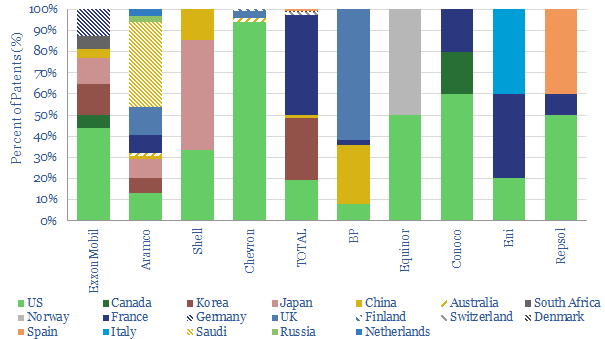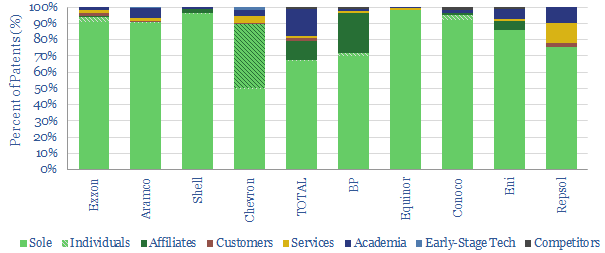This note contains our ‘Top Five’ conclusions about the Oil Majors’ research partnerships, drawing off our database of 3,000 oil company patents. Different companies have importantly different approaches. We can quantify this, by looking at the number of patents co-filed with partners (chart above).
[restrict]
(1) Working with Academia. TOTAL stands out as collaborating most closely with academic institutions, by a wide margin. In 2018, it filed 75 such patents, of which two-thirds were with French institutions. Aramco was next with c40 patents co-filed with Academia. Eni and Repsol filed c4-5 each.
(2) Working with Services. Chevron stands out as working most closely with the Services industry, as it is co-developing two particular technologies: “electro-crushing drilling” with Halliburton, and distributed acoustic sensing with Silixa. We expect Chevron to have a lead in both technologies, before they are licensed out to the broader industry.
(3) Working with Customers. Exxon has co-filed most patents with its customers: advanced lubricants with Toyota and advanced plastics with packaging companies. The moat around Exxon’s IP in both areas is extremely impressive.
(4) Working Internationally. Aramco runs the most global research collaborations, with 5-10 patents filed in each of 5 international countries. This is unusual, as most other companies confine their research partnerships to their home countries (below).

(5) Working Independently. Shell and Equinor run the most independent research processes, filing 96% and 98% of their patents solo. We have been impressed with the technical specialisations both organizations have built up in-house.
Our full database of 3,000 patents is exclusively available to TSE’s subscribers, including short summaries of each patent. For further information, please email us, contact@thundersaidenergy.com
[/restrict]

